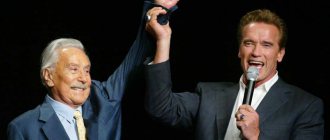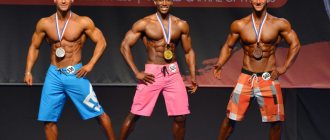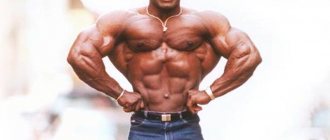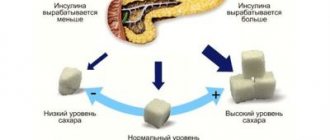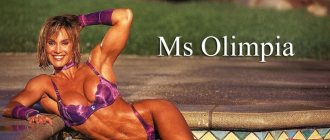Mr. Olympia[edit | edit code]
Mr. Olympia logo
Mr. Olympia
- the most significant international bodybuilding competition held under the auspices of the International Federation of Bodybuilding (IFBB).
Mr. Olympia standings
| Name | the date of the | Location | Prize fund | Winner |
| Mr Olympia 2016 | September 18, 2016 | Las Vegas, USA | — | |
| Mr Olympia 2015 | September 20, 2015 | Las Vegas, USA | 1 115 000 $ | Phil Heath |
| Mr Olympia 2014 | September 20, 2014 | Las Vegas, USA | 1 100 000 $ | Phil Heath |
| Mr Olympia 2013 | September 28, 2013 | Las Vegas, USA | 1 000 000 $ | Phil Heath |
| Mr Olympia 2012 | September 29, 2012 | Las Vegas, USA | 900 000 $ | Phil Heath |
| Mr. Olympia 2011 | September 17, 2011 | Las Vegas, USA | 825 000 $ | Phil Heath |
| Mr Olympia 2010 | September 25, 2010 | Las Vegas, USA | 825 000 $ | Jay Cutler |
| Mr Olympia 2009 | September 27, 2009 | Las Vegas, USA | 800 000 $ | Jay Cutler |
| Mr Olympia 2008 | September 27, 2008 | Las Vegas, USA | 600 000 $ | Dexter Jackson |
| Mr Olympia 2007 | September 29, 2007 | Las Vegas, USA | 550 000 $ | Jay Cutler |
| Mr Olympia 2006 | September 30, 2006 | Las Vegas, USA | 546 000 $ | Jay Cutler |
| Mr Olympia 2005 | October 15, 2005 | Las Vegas, USA | 711 000 $ | Ronnie Coleman |
| Mr. Olympia 2004 | October 30, 2004 | Las Vegas, USA | 400 000 $ | Ronnie Coleman |
| Mr Olympia 2003 | October 25, 2003 | Las Vegas, USA | 404 000 $ | Ronnie Coleman |
| Mr. Olympia 2002 | October 19, 2002 | Las Vegas, USA | 381 000 $ | Ronnie Coleman |
| Mr Olympia 2001 | October 27, 2001 | Las Vegas, USA | 351 000 $ | Ronnie Coleman |
| Mr Olympia 2000 | October 22, 2000 | Las Vegas, USA | 325 000 $ | Ronnie Coleman |
| Mr. Olympia 1999 | October 23, 1999 | Las Vegas, USA | 311 000 $ | Ronnie Coleman |
| Mr. Olympia 1998 | October 10, 1998 | New York, USA | 300 000 $ | Ronnie Coleman |
| Mr. Olympia 1997 | September 20, 1997 | Long Beach, USA | 285 000 $ | Dorian Yates |
| Mr. Olympia 1996 | September 21, 1996 | Chicago, USA | 275 000 $ | Dorian Yates |
| Mr Olympia 1995 | September 10, 1995 | Atlanta, USA | 275 000 $ | Dorian Yates |
| Mr Olympia 1994 | September 10, 1994 | Atlanta, USA | 275 000 $ | Dorian Yates |
| Mr. Olympia 1993 | September 11, 1993 | Atlanta, USA | 275 000 $ | Dorian Yates |
| Mr. Olympia 1992 | September 12, 1992 | Helsinki, Finland | 275 000 $ | Dorian Yates |
| Mr. Olympia 1991 | September 14, 1991 | Orlando, USA | 250 000 $ | Lee Haney |
| Mr Olympia 1990 | September 15, 1990 | Chicago, USA | 200 000 $ | Lee Haney |
| Mr. Olympia 1989 | September 9, 1989 | Rome, Italy | 170 000 $ | Lee Haney |
| Mr. Olympia 1988 | September 10, 1988 | Los Angeles, USA | 150 000 $ | Lee Haney |
| Mr. Olympia 1987 | October 31, 1987 | Gothenburg, Sweden | 120 000 $ | Lee Haney |
| Mr. Olympia 1986 | October 11, 1986 | Columbus, USA | 120 000 $ | Lee Haney |
| Mr. Olympia 1985 | October 26, 1985 | Brussels, Belgium | 100 000 $ | Lee Haney |
| Mr. Olympia 1984 | 1984 | New York, USA | 100 000 $ | Lee Haney |
| Mr. Olympia 1983 | September 24, 1983 | Munich, Germany | 50 000 $ | Samir Bannut |
| Mr. Olympia 1982 | 1982 | London, Great Britain | 50 000 $ | Chris Dickerson |
| Mr. Olympia 1981 | October 10, 1981 | Columbus, USA | 50 000 $ | Franco Colombo |
| Mr. Olympia 1980 | October 4, 1980 | Sydney, Australia | 50 000 $ | Arnold Schwarzenegger |
| Mr. Olympia 1979 | 1979 | Columbus, USA | 50 000 $ | Frank Zane |
| Mr. Olympia 1978 | 1978 | Columbus, USA | 26 000 $ | Frank Zane |
| Mr. Olympia 1977 | 1977 | Columbus, USA | 13 000 $ | Frank Zane |
| Mr. Olympia 1976 | 1976 | Columbus, USA | 5 000 $ | Franco Colombo |
| Mr. Olympia 1975 | November 11, 1975 | Pretoria, South Africa | 2 500S | Arnold Schwarzenegger |
| Mr. Olympia 1974 | 1974 | New York, USA | 1 000 $ | Arnold Schwarzenegger |
| Mr. Olympia 1973 | September 8, 1973 | New York, USA | 1 000 $ | Arnold Schwarzenegger |
| Mr Olympia 1972 | 1972 | Essen, Germany | 1 000 $ | Arnold Schwarzenegger |
| Mr. Olympia 1971 | September 24, 1971 | Paris, France | 1 000 $ | Arnold Schwarzenegger |
| Mr. Olympia 1970 | 1970 | New York, USA | 1 000 $ | Arnold Schwarzenegger |
| Mr. Olympia 1969 | 1969 | New York, USA | 1 000 $ | Sergio Oliva |
| Mr. Olympia 1968 | 1968 | New York, USA | 1 000 $ | Sergio Oliva |
| Mr. Olympia 1967 | 1967 | New York, USA | 1 000 $ | Sergio Oliva |
| Mr. Olympia 1966 | 1966 | New York, USA | 1 000 $ | Larry Scott |
| Mr. Olympia 1965 | September 18, 1965 | New York, USA | 1 000 $ | Larry Scott |
Results Mr. Olympia 2022
| Place | Participant | Reward |
| 1 | Mamdouh Elssbiay | $400 000 |
| 2 | Brandon Curry | $150 000 |
| 3 | Hadi Choopan | $100 000 |
| 4 | Hunter Labrada | $40 000 |
| 5 | Nicholas Walker | $35 000 |
| 6 | William Bonac | |
| 7 | Iain Valliere | |
| 8 | Justin Rodriguez | |
| 9 | Akim Williams | |
| 10 | Mohamed Shaaban | |
| 11 | Roelly Winklaar | |
| 12 | James Hollingshead | |
| 13 | Hassan Mostafa | |
| 14 | Patrick Moore | |
| 15 | Regan Grimes | |
| 16 | Andrea Presti |
Where it all began. Mr. Olympia History[edit | edit code]
The first Mr. Olympia tournament took place on September 18, 1965. Its founding father is Joe Weider, a man to whom many famous athletes owe their well-being. The title of champion in the debut competition was rightfully won by Larry Scott, who amazed the audience with his magnificent biceps; he was also awarded the title of best a year later. In 1987, Larry refused to participate in Olympia, and Sergio Oliva became the new champion. The Cuban nicknamed “myth” was so good that the next year no one could compete with him. But the year 1969 was truly a turning point in the history of the tournament, since it was then that the world learned about a man named Arnold Schwarzenegger. The young Austrian was just one step away from the title, promising that he would win it at the next competition. And Arnie kept his word! In 1970, it was he who was recognized as the best bodybuilder in the world, after which the newly-minted winner said in an interview that this victory was only the beginning of his long journey, and he would not give up his title to anyone as long as he had the opportunity to compete. The confrontation between Arnold and Sergio Oliva is one of the most dramatic in the history of world bodybuilding. So, in 1972, Arnie managed to win thanks to a margin of just one judge's vote. At the same time, Franco Colombo managed to enter the fight for the highest places, however, perhaps the most striking rival of Schwarzenegger, after Sergio Oliva announced his retirement from top-ranking competitions, became Lou Ferigno, a man who achieved success in life thanks to nothing - then, but in spite of everything. Despite school humiliation, problems with hearing and speech. Bodybuilding for Lou became a kind of outlet that allowed him to gain self-confidence and not only go on the same stage with his idol, but almost take the title from him. And even though he failed to do this either in 1974 or 1975, Lou, nevertheless, forever inscribed his name in the history of world bodybuilding.
Meanwhile, the Arnold Era continued. From 1970 until 1975, no one managed to surpass the Austrian. Only after Iron Arnie announced his retirement, concentrating on work in show business, did his friend Frank Colombo manage to get such a long-awaited title. Both athletes walked their path in bodybuilding literally shoulder to shoulder, having met in 1965 in Germany. Before that, young Franco was seriously involved in boxing, but an incident that occurred in one of the fights, when the guy almost killed his opponent with a blow, forced him to leave this sport, and the meeting with Arnie became a fateful moment in his subsequent life. Colombo, in addition to his amazing muscles, is also famous for his outstanding strength indicators, as for a classic bodybuilder; in his best years, his weight in triathlon was almost 900 kg. Unfortunately, it was this that, in a certain way, played a cruel joke on Franco; soon after the Olympia, he was very seriously injured in a strength competition, receiving a doctor’s ban on training. All the more triumphant was Franco's return five years later, when in 1981 he again won the title of Mr. Olympia, again following the example of his friend, who managed to do this a year earlier. It is worth noting that such comebacks are doubly worthy of respect for the reason that over the course of several years, in the late 70s, Olympia’s popularity increased significantly, and along with it, competition also increased.
Biography
Full name Phillip Jerrod Heath , nicknamed "The Gigt", which means gift or talent. Born on December 18, 1979, in the large port city of Seattle, which is located in the northwestern United States and in the state of Washington. From early childhood he had a desire to engage in sports, especially basketball. At the age of 18, Phil Heath successfully passed the entrance examination and was enrolled in one of the oldest private universities - the University of Denver, where he was immediately noticed and invited to play in the men's basketball team as a shooter, or "sniper" in Russian. Heath immediately began to show his positive side and after some time became the best player on the team. A year later, the basketball team led by Heath won the first student division and was awarded a personal sports scholarship. It was basketball that helped cultivate in him such qualities as diligence, determination, discipline and perseverance.
In 2002, Phil Heath graduated from the university and with the same event his career as a basketball player ended. At first, it was hard for him without the grueling and at the same time beloved basketball training, and he bought a subscription to one of the city’s gyms, where he eventually began to train, but as a novice bodybuilder. He thought about this decision for a long time, comparing all the pros and cons, because Phil had a very modest height (175 cm), which slightly interfered with his professional basketball career. As you can see in the photo above, thanks to basketball and genetics, Phil already had an athletic, pumped-up body. He was aware of this, and made a deliberate decision to enter the world of professional bodybuilding. He sought specialized help from experienced trainers who helped him create a quality training plan and proper diet. From that moment his preparation for the big world of bodybuilding began.
Anthropometric data of Phil Heath
- Height: 175 cm
- Competition weight: 114 kg
- Off-season weight: 127 kg
- Neck: 47 cm
- Biceps: 58.5 cm
- Waist: 73 cm
- Hip: 81.3 cm
- Chest: 140 cm
- Calves: 51 cm
Aesthetics to the masses[edit | edit code]
1977, '78 and '79 were the Frank Zane era. A man who managed to get the title of Mr. Olympia primarily thanks to the frantic determination that the guy developed, not least due to his studies at the Faculty of Psychology. In his case, this factor became one of the decisive ones, since Frank himself is a pronounced ectomorph, which is why he had to abandon the idea of becoming huge at the dawn of his career. Zane’s main emphasis was on developing the aesthetics of his body, working out the relief, achieving almost ideal proportions. And therefore, his Mr. Olympia titles look well deserved.
Ronnie's back[edit | edit code]
This is usually what happens: powerful biceps, which grow as if on their own, do not allow the back to develop normally, taking the main part of the load on itself in back exercises. I know that many athletes with almost perfect hands cannot “break through” their back - this is a common problem. Coleman's arms are a masterpiece; he practically doesn't train his biceps in the off-season, giving him the opportunity to get a load just while working on his back. At the same time, Ronnie’s back is almost perfect - very wide and worked out to the smallest detail. How could this happen? In order to understand this, you need to take a closer look at Coleman’s back training, which we will do now.
Scandals, intrigues, investigations[edit | edit code]
If from the moment of his first victory over the next two years Zane constantly improved his form, then before the 1980 Olympia he no longer looked like a favorite of the competition. However, Mike Mentzer, who lost the champion title to Zane a year earlier, did a tremendous amount of preparation. Boyer Coe and Chris Dickerson also kept pace with their competitors. But the main sensation of the competition was none other than the return of Arnold Schwarzenegger, which he announced literally a few weeks before the tournament, having spent only about two months preparing for it. Many were skeptical about this decision, believing that Arnie had no chance, but meanwhile the tension was growing. Arnold almost got into a fight with Mentzer during one of the official meetings, during which it was decided whether to abolish the division by weight categories. Schwartz opposed, apparently fearing that he would not be able to beat the lighter weight athlete in the overall standings. During the negotiations, he nevertheless agreed with the other participants that the format should be left as it was, but everyone felt that the situation had become tense. Perhaps this is exactly what Arnie focused on, trying to cause confusion among his opponents, which, in fact, happened. The tension in the air was felt on stage, especially when, after the first round of posing, Arnie took the lead, despite the fact that the judges' scores looked rather contradictory. The public's reaction to Arnold's final victory made it clear that not everyone considered his first place deserved, and his opponents were not shy in their expressions. Boyer Ko quipped about Arnold's "chicken legs" in an interview, and Mike Mentzer cursed dirty on stage. Frank Zane, most likely, understood that his lack of mass would not allow him to win the title for the fourth time in a row, but he clearly did not like the fact that it was Arnie who became the winner. Some experts said after the competition that for Arnold, with his form, happiness at the 1980 Olympia should have been even getting into the top five. People loyal to Arnold noted that each of the participants had their own pros and cons, but Arnold outplayed his competitors, first of all, as a showman, on a psychological level. That’s right, during his performance he constantly turned on the audience, stood on those parts of the stage where the play of lighting on his muscles was most advantageous and used other similar techniques.
The “aftertaste” of Olympia 1980 makes itself felt even today, in our days. Disputes continue and will continue about whether Arnold won a fair victory, with each side presenting its own arguments, defending one opinion or another. At the same time, most professionals prefer not to remember the most scandalous competitions in the history of bodybuilding, constantly evading answers. This especially applies to the direct participants of that very tournament. Be that as it may, Schwarzenegger’s triumph is an already established fact that has gone down in history, and since it caused such a resonance, it means that bodybuilding is truly more than a sport.
Sergio Oliva
Sergio was a three-time Mr. Olympia from 1967 to 1969. The bodybuilder died at the age of 71. His son, Sergio Jr., followed in the athlete’s footsteps. With a height of 175 cm, Oliva weighed about 108 kg. Sergio was the main competitor of Arnold Schwarzenegger, who debuted in 1969. After Arnie became second to Olive, he promised himself that this would not happen again - and it did. Sergio's career lasted more than twenty years, and it ended in 1986. By the way, in the same year Sergio received six gunshot wounds inflicted by his own wife. After this, the couple, oddly enough, divorced.
There is a record! Mr. Olympia winners[edit | edit code]
Having won his seventh victory at Mr. Olympia, Arnie announced that he was finally finishing his participation in this tournament, becoming one of its main organizers. Largely thanks to his efforts, the prize fund of the competition increased tenfold, which significantly increased the prestige of the competition and its popularity in the world. In 1982, Chris Dickerson won the title, a year later Samir Bannout became victorious, for whom this victory is the only serious achievement in his career. Already at these competitions, judges and spectators highly praised the young Lee Haney, the future record holder for the number of Mr. Olympia titles. He began his winning path in 1984, receiving $100,000 for first place - the largest fee in the history of Olympia at that time. Lee Haney was the perfect combination of bulk and definition. He wasn't just big, he was perfectly proportioned big. Lee's hegemony lasted until 1991 inclusive, while serious competitors in the person of Lee Labrada, Vince Taylor, Dorian Yates and Sean Ray appeared no earlier than 1989. At the 1991 Olympia, Haney managed to snatch victory from Yates only at the last moment, and it was after this triumph that he announced that he was ending his performances at these competitions. Eight victories in a row is a truly great result, thanks to which many people consider Lee Haney to be the best bodybuilder in the history of world sports.
Final comparison Top 2
iHerb Original products from global sports nutrition brands at the best prices
- Citrulline Malate
Primaforce
Increases performance, helps increase muscle mass, improves ATP production, helps increase cell volume
View price
- Pre-Workout Cellucor
C4 Sport
Pre-workout complex, provides an energy boost, improves performance
View price
- Whey, Gold Standard
Optimum Nutrition
Whey Protein: Whey Protein Isolate, Whey Protein Concentrate, Whey Peptides
View price
- 100% Whey Gold
muscletech
Whey Protein: Blend of Protein Isolates and Peptides (Whey Peptides, Whey Protein Isolate, Whey Protein Isolate 97%)
View price
- Multivitamins ANAVITE
Gaspari Nutrition
Vitamin-mineral complex
View price
| AKL7443 + VALUE60 | additional discount 5-10% |
| Free shipping | for orders over 40 usd |
Purely English murder... of competitors[edit | edit code]
The period 1992-1997 became the era of Dorian Yates. Among athletes it is believed that it was he who brought the “mass fashion” to the world of bodybuilding, and not everyone considers this fact positive. However, even opponents of overly massive athletes do not in the least detract from the Briton’s achievements, just as his opponents did in their time, admitting that Yates was unattainable in the mid-90s. Despite the fact that in 1994 he had to make titanic efforts to recover from a serious injury received 9 weeks before the competition, and more and more serious opponents were stepping on Dorian’s heels from year to year, such as Nasser el Sonbati, Sean Ray and Kevin Levrone. However, it was not they who managed to move Yates off the pedestal, but a policeman named Ronnie Coleman, an athlete who has no equal in weight among all the athletes who have ever taken part in Olympia.
Ronnie Coleman's training split[edit | edit code]
Ronnie's training split remained virtually unchanged throughout his career - six days a week - work, the seventh is dedicated to rest. Monday - chest, triceps, calves, abs Tuesday - quadriceps, hamstrings Wednesday - back, biceps, calves, abs Thursday - chest, shoulders, triceps Friday - quadriceps, hamstrings, abs Saturday - back, biceps, shoulders, calves Sunday - rest The back, like any other muscle group of Ronnie, is loaded twice a week. The athlete considers this training frequency to be optimal for growth. There is no division into training aimed at the mythical “thickness” and “width” - the exercises are very similar. Let's say, on Wednesday he can do rows of the T-bar and dumbbells to the belt (by the way, Ronnie often performs the last exercise with both hands at the same time), and on Saturday - rows of the upper and lower blocks (the first - to the chest, the second - to the belt), and also bent over row of the barbell to the waist. By the way, tilt in the latter case is a very relative concept: Ronnie leans forward so that the top of his body makes an angle of at least 70 degrees with the floor. So what's the secret? Firstly, the use of very large weights. In this case, the hands cannot help significantly, and the main load goes to the lats. Secondly, Ronnie always uses safety harnesses. Once again, the hands are turned off from work, serving in fact only as a transmission link between the projectile and the back. Finally, the athlete actively uses “cheating”, lifting the weight with the help of the whole body, rather than trying to move it “slowly and in a controlled manner.” After all, the arms work only in the initial phase of the movement, and if it is possible to overcome it due to inertia, then it is the back muscles that will come into action. It seems simple. In my opinion, it’s worth a try: maybe these secrets will help you too?
Source Iron World No. 4
"This cop is bigger than his car"[edit | edit code]
During his first victory, Ronnie weighed 121 kg, and subsequently Ronnie’s competitive weight reached almost 140 kg. It is noteworthy that at that time Colman was no longer young, which still did not prevent him from remaining triumphant for the next seven years, during which he constantly improved his physical shape. Kevin Levrone had to be content with only second and third places, which, taking into account Colleman's progress, were the ceiling for all other participants in the competition. Only in 2006 did Jay Cutler, the only holder of the Mr. Olympia title to date, manage to bypass the “biggest cop in the world,” who regained it after losing, and not leaving and returning to the sport, as Schwarzenegger and Colombo did.
Ronnie Coleman[edit | edit code]
Read main article
: Ronnie Coleman.
It’s difficult to talk to him: extreme slowness (this is also called deliberation) in answers, a drawling and not entirely understandable southern dialect for an unprepared listener, transform the conversation into a kind of meditation, when you realize that you don’t understand so much, and you renounce reality, giving in to the flow of conversation. And why ask: everyone already knows absolutely everything about “Big Ronnie”. And he was used to answering with stereotypical phrases - discovering something new in such conditions is much more difficult than finding a needle in a haystack. In general, it’s a complete torment. Nevertheless, we managed to get something out of him. Read this article: I hope it will be interesting, and you will be able to learn at least a little of what you didn’t know about the eight-time Mr. Olympia before.
New era of Mr. Olympia[edit | edit code]
In total, Jay's collection includes four victories in the competition - 2006, 2007, 2009 and 2010. This cycle was “diluted” by Dexter Jackson, an athlete who amazed the audience with his magnificent relief during Jay Cutler’s second victory. By that time, Colleman had gradually begun to decline, taking only fourth place at the 2007 competition, and Jay Cutler’s main competition was an athlete from the Dominican Republic, Victor Martinez. However, Ronnie received perhaps the loudest ovation from the audience, as the man who repeated Lee Haney's record for the number of titles won, which, of course, is a colossal achievement.
In turn, Dexter Jackson, who made the appropriate conclusions, reached the peak of his form in 2008, showing the whole world what an ideal muscle definition should be. And even though this victory still remains the only one in his career, its significance is difficult to overestimate. Just like the one that Jay Cutler won a year later. The weight of this victory is largely reinforced by the fact that it was in 2010 that a number of athletes took part in the competition, rightfully considered to be among the best in the entire history of bodybuilding. In addition to Cutler himself, the same Dexter Jackson and Victor Martinez, as well as Denis Wolf, Kai Greene, Branch Warren and Phil Heath competed for the title. It was the latter who became the “successor” of Jay Cutler on the highest step of the podium. Cutler himself served as the ideological inspirer of this short guy from Seattle, seeing in him a future champion at one of the regional competitions. Athletes constantly support each other at tournaments, rejoice in victories together, showing the whole world that bodybuilding truly unites, and even being rivals on stage, you can be good friends in life.
Interest in Olympia only increases every year, facilitated by ever-increasing competition. Even though Phil Heath has become the champion for the third year in a row, his main opponents, namely Kai Greene, Dexter Jackson and Dennis Wolf, along with many other eminent athletes, according to many experts, are almost in no way inferior to him. And this means only one thing - soon we will see many more vivid and emotional confrontations that will remain in our memory for many years!
Phil Heath
In 2011, Cutler's student and friend Phil Heath managed to defeat Jay, pushing him to second place. In 2012, during Jay Cutler's absence due to injury, it was easy for Phil to become the winner for the second time. In 2013, Jay failed to show decent form, so he took only 6th place, and Phil Heath again celebrated his victory. In 2014, there was again intrigue between Kai and Phil, but the four-time champion again showed the best form.
At the end of the article, I suggest you watch 2 videos. On the first you can watch the first 12 champions, on the second video a video with Phil Heath's victory at the 2011 Olympia.
